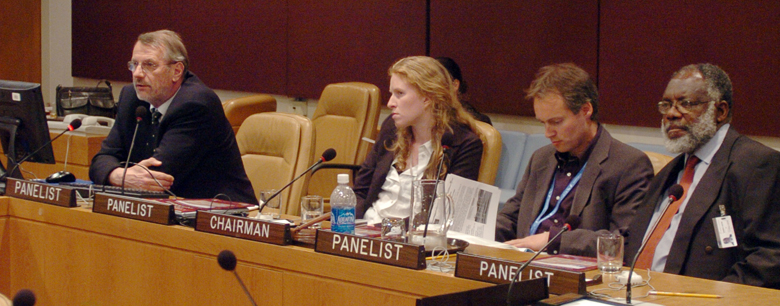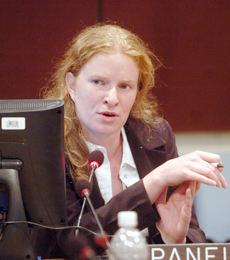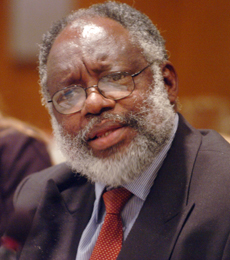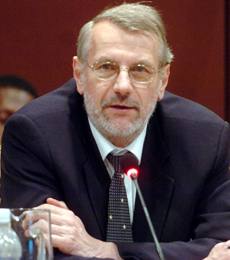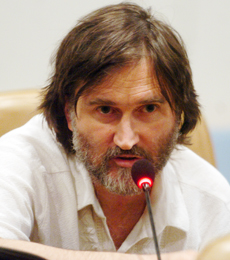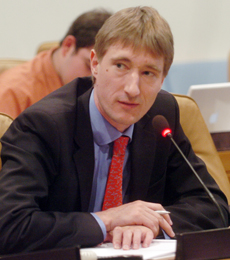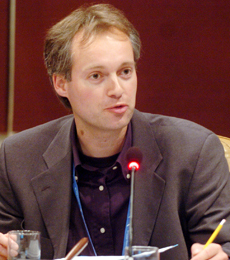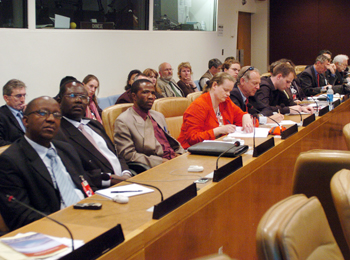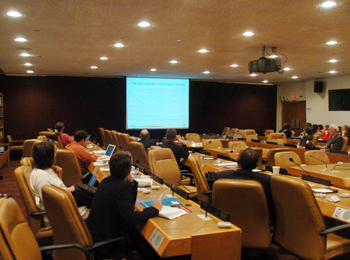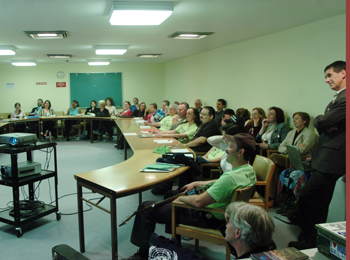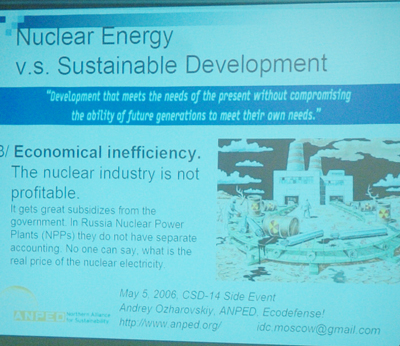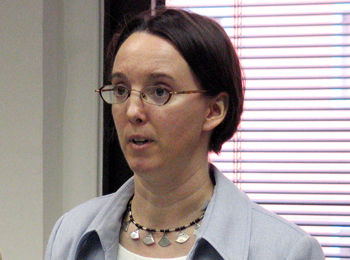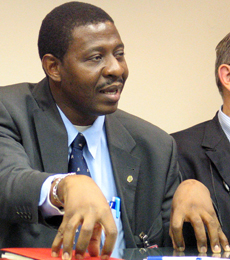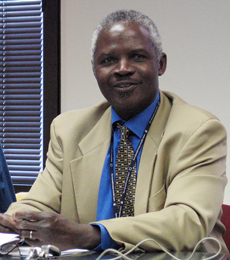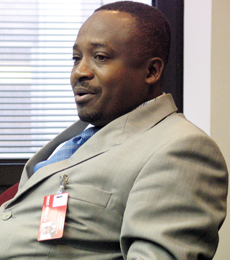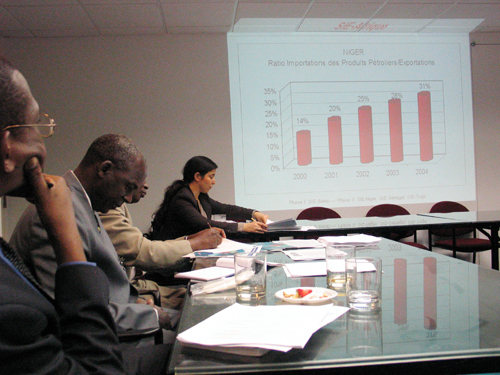 |
||
|
published by IISD, the International Institute for Sustainable Development
in cooperation with the UNDP Secretariat |
|||
|
Special Report on Selected Side Events at the Fourteenth Session of the Commission on Sustainable Development (CSD-14)
|
|||||
| 1-12 May 2006 | United Nations Headquarters, New York | |||||
 |
 |
|||
 |
||||
Events convened on Friday, 5 May 2006
|
Mobilizing Environmental Finance for Sustainable Development: The MDG Carbon Facility Presented by UNDP |
|||
|
Kalman Mizsei, Chair, UNDP, noted that by 2010, development assistance will have doubled since 2000, but emphasized that the amount will still fall short of that required to meet the MDGs. The solution, said Mizsei, is financing ecosystem services, such as the carbon cap and trade program, highlighting the benefit of these not being tied to political agreement. He said that UNDP can play a pivotal role in helping poor countries identify suitable sources of finance, and provide project and management support, highlighting UNDP’s MDG Carbon Facility.
Yannick Glemarec, UNDP, said environmental finance provides unprecedented opportunities for developing countries, but also poses challenges, such as how to combine and sequence different financing instruments. He discussed the MDG Carbon Facilities’ role in addressing these challenges, including increasing access to carbon finance for a broader range of developing countries and project types by providing a one-stop shop service in carbon finance. He added that another role the facility could play includes maximizing the carbon development dividend through developing a MDG Carbon Portfolio, which strikes a balance between cost-effective projects and high development impact projects. Stephen Gitonga, UNDP Small Grants Program (SGP), discussed the potential for engaging communities in carbon finance, saying that SGP-type projects are very useful for attaining MDG outcomes in agriculture and education, but their low certified emission reduction units are a barrier to accessing carbon finance. However, noted Kitonga, the opportunities to combine small community based projects is an emerging opportunity, emphasizing that UNDP is looking at ways to facilitate CDM activities and other emerging opportunities that incorporate LDCs and SIDS into the equation. John Van Lewis, Executive Director Climate Investment Network for Carbon Sequestration (CINCS), highlighted CINCS pilot projects including a possible LULUCF reforestation project, saying CINCS projects can fulfill the CDM project demand gap. He provided an example of projected additional income from a traditional West African agro-forestry system, and addressed key issues for pro-poor payment environmental services, including that they must integrate with ongoing field programs. Noting the ongoing reform in the CDM market, Brian Dawson, UNDP, emphasized that it will become easier and more recognizable to bring small projects into it. He said the MDG Facility’s goal is to develop projects with high MDG outcomes and involve the LDCs. Discussion: Participants discussed many issues, including: MDG Carbon Finance Facilities’ constraints; the need for capacity building in MDG Carbon Facilities projects; the post-2012 carbon market; and the need to involve communities in projects. |
|||
Around the Side Event
|
|||
|
The IPCC Special Report on Carbon Dioxide Capture and Storage Presented by the Intergovernmental Panel on Climate Change (IPCC) |
|||
|
Ogunlade Davidson, Co-chair, IPCC, introduced the Carbon Dioxide Capture and Storage (CCS) Report, saying it was extensively reviewed by over 200 experts from 30 countries and first presented at UNFCCC COP 11/MOP 1. He noted that CCS could play a mitigating role in climate change by being a part of a portfolio of mitigation options.
Hans-Holger Rogner, IAEA, described the technical aspects and risks of CCS. He highlighted the various location options for CO2 storage, including depleted oil and gas fields, injection into deep rock formations, and the deep sea, saying that from purely a point source perspective carbon capture might be worth pursuing. He said that CCS requires an additional energy use of 10-40% and addressed the health, safety and environmental risks, saying that not much information exists, but that geologic storage would necessitate appropriate site selection, monitoring, regulation, and remediation methods to stop leakages if they occur. Heleen de Coninck, Energy Research Center of the Netherlands, said the report assessed potential costs through two lenses: the energy community and the climate policy-making community, noting that costs are variable, but at its cheapest, CCS costs 2-3 cents/Kwh. She noted that capture is the primary expense of CCS and that when used in the energy scenario portfolio, this will make renewable energy and energy efficiency a lesser component of the portfolio, though it would reduce overall costs of mitigating GHG emissions. Highlighting geologic storage as the only current viable option, she said that enough CO2 can be trapped to cover the high end of the economic potential range, and closed by addressing leakage, saying that the fraction of CO2 retained in geological reservoirs, if appropriately managed, is over 99% over 1,000 years. Erwin Mulders, Ministry of Housing, Spatial Planning and the Environment, the Netherlands, described domestic CCS policies, highlighting the Netherlands' oil industry, saying that they have a transition approach to sustainable energy systems which welcomes all energy options in order to tackle climate change, emphasizing that they do not support ocean storage. He addressed the debate over whether industry or government will pay for CCS, as well as the Netherlands’ nascent debate over whether to store Russian gas or CO2 in their depleted oil fields. Discussion: Participants addressed many issues, including: the issue of joint implementation and approval for CDM; pricing of renewables versus CCS; current CCS pilot projects; and why the report did not take into account transportation. |
|||
|
|||
|
The Sustainable Production and Consumption of Energy: Views from Civil Society Presented by Citizens Network for Sustainable Development |
||||
|
Jeffrey Barber, Citizens Network for Sustainable Development, commented on how the term “sustainability” is open to interpretation, and emphasized that it should consider equity, and consumption levels. He said that while energy consumption grows, along with ecological impacts, quality of life is decreasing for much of the world. He noted that marketing plays a key role in telling people what they “need.” Andrey Ozharovskiy, Northern Alliance for Sustainability, presented a case study on Russian civil society’s perspectives on nuclear energy. Noting repeated attempts by industry to label it a “green” source of energy, he elaborated on risks associated with it that indicate otherwise. Several speakers from Appalachian communities in the U.S. provided testimony regarding the hazards associated with mountain top removal coal mining in their region, including elevated cancer rates, asthma, and liver disease. One participant announced that during CSD-14 she had personally delivered a sample of contaminated water to the owner of the International Coal Group, Wilbur Ross. Patrich Feeney, Appalachia Coalition, lamented the amount of resources that have been spent convincing people that coal is a green resource, and questioned whether there is a role for grassroots groups participation in the CSD. She expressed alarm at the large amount of coal by-products that are pumped underground, which threaten well water and cause adverse health effects. She said that governments have hijacked the “access to energy” agenda, turning it into “access to energy at any cost.” Don Brown, Pennsylvania Consortium for Interdisciplinary Environmental Policy, depicted climate change as the most serious environmental problem, but noted positive trends associated with state-level action, adding that these need to be nurtured. He noted progress achieved in universities in securing behavioral, as well as technological change. He described how equity and ethics are woven into the debate over climate change and emissions, as it will be the poorest people that will suffer most, yet who have historically contributed the least to the problem. Bryan Ashe, African Rivers Network, described the exploitation of South Africa for aluminum development, based on cheap hydro energy diverted from local communities. He expressed alarm at the impending prospect of damming the Congo River, adding that this could have greater impacts than the Three Gorges Dam in China, and challenged the idea that large hydro is a renewable energy source. Discussion: Participants discussed the relationship between land tenure, environment and women; the development of green alternatives to fossil fuel; and prospects for future action on climate change. |
||||
|
|||
|
Le Système d’Information Energétique en Afrique Presenter par: L’Organisation Internationale de la Francophonie (OIF), L'Institut de l'énergie et de l'environnement de la Francophonie (OIF/IEPF); Consultants ECONOTE |
||||
|
Sibi Bonfils, de l’OIF/IEPF, a donné un aperçu sur la structure et les objectifs du projet Système d’Information Energétique (SIE) en Afrique, et sur l’atelier consacré à SIE-Afrique. Il a présenté le cadre générale du projet et a décrit le travail de renforcement de capacités dans les domaines de l’énergie et de l’environnement, citant à titre d’exemple, les réformes entreprises dans le secteur de l’électricité, et la mise en place de partenariats avec le PNUD, la Banque Mondiale et le PNUE. Il a indiqué que l’objectif global du projet SIE consiste à doter les pays d’Afrique de systèmes d’informations énergétiques opérationnels, axés sur les applications concrètes. Chantal Guertin, de l’OIF/IEPF, a donné de plus amples détails sur le projet SIE, signalant au passage que peu de pays africains disposent jusque là de renseignements et de données sur leur secteur énergétique. Elle a présenté le processus de travers lequel les pays candidats ont été sélectionnés pour le projet qui s’est déroulé en deux étapes. La première a eu lieu au Bénin et a été financée par l’IEPF, le gouvernement béninois et la commission européenne (Programme SYNERGIE). La deuxième a eu pour au Niger, au Sénégal et au Togo et a été financée par l’OIF, la commission européenne (Programme COOPENER) et les trois pays concernés. L’oratrice a énuméré les nombreux résultats du projet qui ont englobé, notamment, l’établissement un bilan global et détaillé du secteur énergétique de chacun des pays mentionnés. Justin Agbo, du Ministère des Mines, de l’Energie et de l’Eau, au Bénin, a présenté l’expérience béninoise avec le projet SIE et a cité des exemples illustrant les résultats accomplis dans ce cadre, dont une analyse de l’évolution de la consommation énergétique, par source. L’étude a montré pour l’essentiel, que la demande en matière de bois-énergie va bientôt dépasser l’offre. L’orateur a indiqué que le projet a aidé à convaincre le gouvernement de l’importance de ce secteur et de la nécessité de lui accordé davantage d’attention en veillant à en diversifier les sources. Discussion: Les participants ont examiné de nombreux sujets et, notamment: la méthode d’entraînement employée dans le cadre du SIE; la pérennité institutionnelle, la relation entre les PRSP, les ODM et le secteur de l’énergie, et, l’importance de la séparation des données et de leur présentation de manière sexo-spécifique. |
||||
|
|||
|
Energy Information Systems in Africa Presented by the International Francophone Organization (OIF), the Francophone Institute for Energy and Environment (IEPF), and ECONOTEC Consulting |
||||
|
Sibi Bonfils, OIF/IEPF, described the structure and objectives of the Energy Information System project in Africa, and gave an overview of the workshop. He described the project framework, the capacity building that took place, and the development of partnerships with UNDP, the World Bank, and UNEP. He underlined that the goal of the project was to empower African countries with operational information systems that achieve concrete results. Chanta Guertin, OIF/IEPF, elaborated on the SIE project, noting that there are few African countries able to provide the necessary energy sector data. She presented the country selection process, and the two separate project phases: the first, in Benin, was financed by IEPF, the government of Benin, and the European Commission (SYNERGY Programme). The second phase, still underway, involves Niger, Senegal and Togo, and is financed by OIF, European Commission (COOPENER Programme), and the countries involved. She listed many positive project results, including a detailed assessment of each country’s energy sector. Justin Agbo, Ministry of Mines, Energy, and Water, Benin, presented his country’s experience with SIE, and described a few examples of the benefits achieved, for example, an analysis of sources of energy consumption and supply, which showed that the demand for fuelwood is rapidly exceeding supply. He said that the project has helped convince government of the sector’s importance, and of the need to consider diversifying energy sources. Discussion: Participants discussed a range of topics, including the SIE method of “coaching,” the relationship between energy, the PRSPs, and the MDGs, and the importance of disaggregating data, and the role of gender equity. |
||||
|
|||
|
||
|
Click the above button to go back to our ENB main coverage
|
||
|
|
|
|
|
||
|
-tn.jpg)
-tn.jpg)
-tn.jpg)
-tn.jpg)
-tn.jpg)
-tn.jpg)
-tn.jpg)
-tn.jpg)
-tn.jpg)
-tb.jpg)
-tn.jpg)
-tn.jpg)
-tn.jpg)
-tn.jpg)
